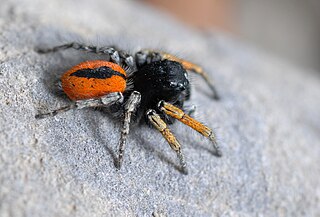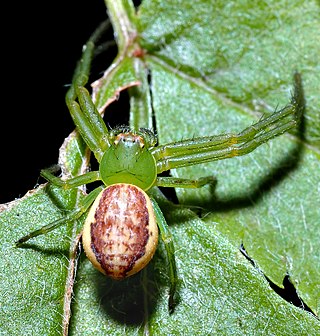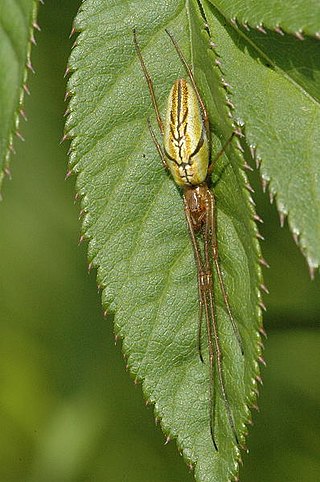
Myrmarachne is a genus of ant-mimicking jumping spiders that was first described by W. S. MacLeay in 1839. They are commonly called ant-mimicking spiders, but they are not the only spiders that have this attribute. The name is a combination of Ancient Greek μύρμηξ, meaning "ant", and ἀράχνη, meaning "spider".

Philaeus chrysops is a species of jumping spider (Salticidae).
Bathippus is a genus of jumping spiders.

Euophrys is a genus of jumping spiders that was first described by Carl Ludwig Koch in 1834. The small black E. omnisuperstes lives on Mount Everest at elevations up to 6,700 meters, possibly making it the most elevated animal in the world.

Heliophanus is a genus of the spider family Salticidae. Most of the almost 170 described species occur in Africa, with many others found in the Palearctic region from Europe to Japan.

Hyllus is a genus of the spider family Salticidae. Most species occur in Africa and Madagascar, with many in Australasia and north to India. H. insularis is found in Greece and Iran, but it is considered misplaced in this genus, and is now Evarcha insularis.

Menemerus is a genus of jumping spiders that was first described by Eugène Louis Simon in 1868. They are 4 to 10 millimetres long, flattened in shape, and very hairy, usually with brown and grayish hairs. Most species have white edges on the thorax. The abdomen is often oval, or sometimes elongated or rounded.

Pellenes is a genus of jumping spiders that was first described by Eugène Louis Simon in 1876. It is considered a senior synonym of Hyllothyene.

Phintella is a genus of jumping spiders that was first described by W. Bösenberg & Embrik Strand in 1906.

Phlegra is a genus of jumping spiders that was first described by Eugène Louis Simon in 1876. The name is a reference to a mythical location in both Greek and Roman mythology.

Rhene is a spider genus of the family Salticidae.

Thyene is a genus of jumping spiders that was first described by Eugène Louis Simon in 1885. It is a junior synonym of Mithion, and senior synonym of Brancus, Paramodunda and Gangus.

Cheiracanthium, commonly called yellow sac spiders, is a genus of araneomorph spiders in the family Cheiracanthiidae, and was first described by Carl Ludwig Koch in 1839. They are usually pale in colour, and have an abdomen that can range from yellow to beige. Both sexes range in size from 5 to 10 millimetres. They are unique among common house spiders because their tarsi do not point either outward, like members of Tegenaria, or inward, like members of Araneus), making them easier to identify.

Diaea is a genus of crab spiders first described by Tamerlan Thorell in 1869. Most species are found in specific locations except for D. livens, which occurs in the United States and D. dorsata, which has a palearctic distribution. Adults are 5 millimetres (0.20 in) to 7 millimetres (0.28 in) and tend to hide in and around vegetation, especially flowers, where their color allows them to blend in to their surroundings.

Theridion is a genus of tangle-web spiders with a worldwide distribution. Notable species are the Hawaiian happy face spider (T. grallator), named for the iconic symbol on its abdomen, and T. nigroannulatum, one of few spider species that lives in social groups, attacking prey en masse to overwhelm them as a team.

Tetragnatha is a genus of long-jawed orb-weavers found all over the world. It was first described by Pierre André Latreille in 1804, and it contains hundreds of species. Most occur in the tropics and subtropics, and many can run over water. They are commonly called stretch spiders in reference to their elongated body form and their ability to hide on blades of grass or similar elongated substrates by stretching their front legs forward and the others behind them. The name Tetragnatha is derived from Greek, tetra- a numerical prefix referring to four and gnatha meaning "jaw". Evolution to cursorial behavior occurred long ago in a few different species, the most studied being those found on the Hawaiian islands. One of the biggest and most common species is T. extensa, which has a holarctic distribution. It can be found near lakes, river banks or swamps. Large numbers of individuals can often be found in reeds, tall grass, and around minor trees and shrubs.

Thomisus is a genus of crab spiders with around 142 species described. The genus includes species that vary widely in their ecology, with some that are ambush predators that feed on insects visiting flowers. Like several other genera in the family Thomisidae, they are sometimes referred to as flower crab spiders, from their crab-like motion and their way of holding their front legs, reminiscent of a crab spreading its claws as a threat.

Olios is the largest genus of huntsman spiders, containing 166 species. They are found throughout the world, with most species occurring in hot countries. The genus was first described by Charles Athanase Walckenaer in 1837.

Dipoena is a genus of tangle-web spiders that was first described by Tamerlan Thorell in 1869.


















